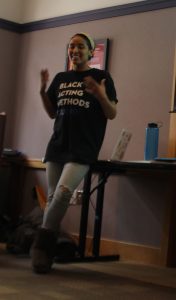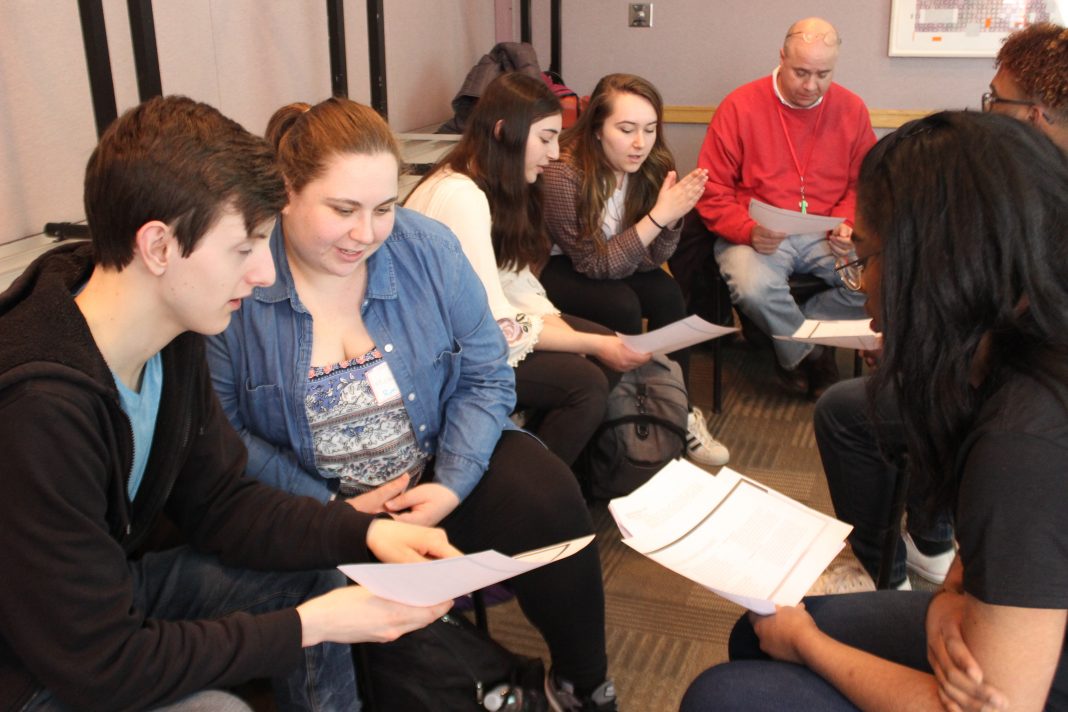Some people say that there are only a select number of stories to tell, and every new story is just a re-iteration of an old plot, revived for the next generation of spectators. In some ways, this may be true. But in some ways this is simply a blindness or unwillingness to acknowledge groups or storytelling methods that are different from what we see in the mainstream mass entertainment sector. I had the privilege of attending a symposium this past Saturday that was created and facilitated by the Black Acting Methods Studio.
The event was called “Diversity in the Arts,” a multi-part conversation and workshop session that draws attention to issues of color-conscious artistry, Afrocentricity and identity in the arts. Dr. Sharrell Luckett, assistant professor of Theatre and Dance and a new member of the theater faculty, recently founded the studio here at Muhlenberg.
What was so amazing and refreshing about this workshop was that it directly confronted questions that would typically go unacknowledged on a day-to-day basis here at school, unaddressed by white students made uncomfortable by the subject.
A great example comes from the section in the workshop about color-conscious casting. A group of about eight white students and one white professor were handed sheets of paper by three facilitators of color. On the sheets of paper were four plays and descriptions of their plots and characters: “All My Sons” by Arthur Miller, “A Raisin in the Sun” by Loraine Hansberry, “Angels in America” by Tony Kushner and Shirshir Kurup’s reimagining of “The Merchant of Venice”.The facilitators then asked participants which plays we would choose to do in an educational setting. In a typical Acting I or II class at Muhlenberg, students are given a variety of plays to choose from to work on in class. Upon reflection on my own experience in these classes, I realized that all of the parts in almost every play were white character roles. There are people of color in acting classes, of course, but they are expected to adopt a white character role for an educational purpose, even though they do not identify with that racial background. So the facilitators flipped this concept on its head, and asked us what we would do if we had to cast white students to play roles typically played by people of color. Every person in the group showed discomfort in taking on the role of a character of a different race. But this is something that students of color have to deal with all the time. It was extremely enlightening, and something that typically goes unacknowledged in our educational theater setting.
This particular workshop became even more provocative when the facilitators addressed casting calls that advertised “All Actors Welcome.” Frederick Marte ‘20, one of the facilitators, passed us all out more sheets with a fake casting call that said “All Actors Welcome” and the names and character descriptions of the roles being looked for. There were about eight to ten role descriptions, varying in gender and age. However, the names of the characters alluded to the fact that the characters came from a specific cultural background. For example, we received a sheet with names that would appear to be of Hispanic, Asian, or African descent. And then we received a sheet with names that are typically associated with white people. But none of the ages or the genders of the characters changed. At the top of each of these sheets was “All Actors Welcome,” which is a phrase we typically see in casting at Muhlenberg. It made me question the phrase itself, because in reality, not all actors are welcome for certain roles. So does a person of color feel less welcome auditioning for a role that they think would typically be played by a white person, even though a casting call says “All Actors Welcome?”
Luckett came in afterwards and explained that when you put a body of color on stage, no matter what the background of the role being played, there will always be a cultural connection associated with them that cannot go unacknowledged. The goal was to make the group, comprised of theater makers, aware of this so that perhaps future theater-making can explore stories that are outside of what is considered “mainstream Eurocentric.”
Another highlight of the workshop was on Afrocentrism, led by Asia DeShields. She led us through a movement warm up, and then asked us to embody certain words in frozen positions. She started out with words like “happy” or “sad” that can be captured in some type of bodily freeze. And then she asked us to embody the phrase “black girl genius.” As a group of white bodies, it was difficult at first to know exactly what to do. Many members of the group adopted a pose that seemed deep in thought, or proud of the fact that they were smart. She then asked us to embody the phrase with an Afrocentric-lens, and the bodies changed significantly. Participants changed pointing at their brains to putting their arms in the position of a hug or an embrace, from acknowledging intelligence to literally embracing intelligence.

We then sat down for a discussion, prompted with the question, “What would black people do if there were no white people?” We talked about it in small groups. It was difficult to even find a thought to bounce off of for this question.
Michaela Barczak ‘19 phrased an interesting thought, saying “It makes me think of the way that the white, hegemonic, masculine person is viewed as the ‘norm’ or the center of the American population, and how other groups compare themselves to that center.”
This comment led directly into an explanation of Afrocentrism, or the moving of the center to a place where people of color do not have to define something in comparison to something Eurocentric. Luckett explained this in terms of theater by talking about the Stanislavski acting method, the primary method used here at Muhlenberg, which was developed in Russia by Konstantin Stanislavski. But Luckett, when she was learning acting, initially learned about the Hendricks method, developed by Freddie Hendricks, an African American theater director. The Hendricks method was her center, and it was not until she learned that other actors used the Eurocentric Stanislavski method and referred to it as “the method” that she realized her method was not acknowledged by a large section of theater. The goal of Afrocentrism, then, is to be able to acknowledge something like the Hendricks method without automatically comparing it to the Stanislavski method at the center. Both methods can exist independently and people can choose what is effective for them.
At the close of the day, we stood in a circle, and sent the pulse around as we reflected on how we felt about the day. Each person was enlightened and touched by the conversations and the workshop. This demonstrates that there is a desire for more workshops like this here at Muhlenberg.
Amisha Datta ‘21, a student that worked with Luckett on this symposium, said “I am Indian American and I moved to Muhlenberg from China, so I definitely brought an international world view to the symposium,” she said. “Through that I was able to provide interesting context and examples to a lot of scenarios throughout my workshop. I also brought my perspective as an artist of color to the symposium … I was able to take my different experiences to show the participants throughout the symposium that what we were learning about and discussing wasn’t just about acting or performance, and actually applicable to all theatre, art forms, and life.”
Datta also spoke about why she thought the symposium was important for Muhlenberg.
“Muhlenberg is a predominately white campus with a bustling theatre program,” she said. “However, when viewing the classes offered and the kind of plays and musicals selected, it is clear that minority students are not always taken into consideration. It’s so important to have events like our symposium because they foster conversation and learning. Rather than pointing fingers and blaming people for what our campus lacks, these events help us all figure out how to move forward as a community and understand one another.”






















